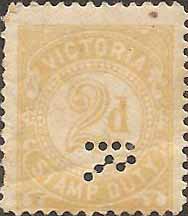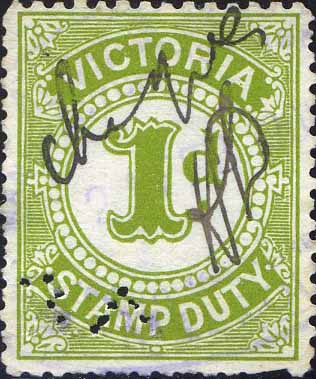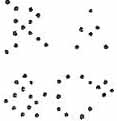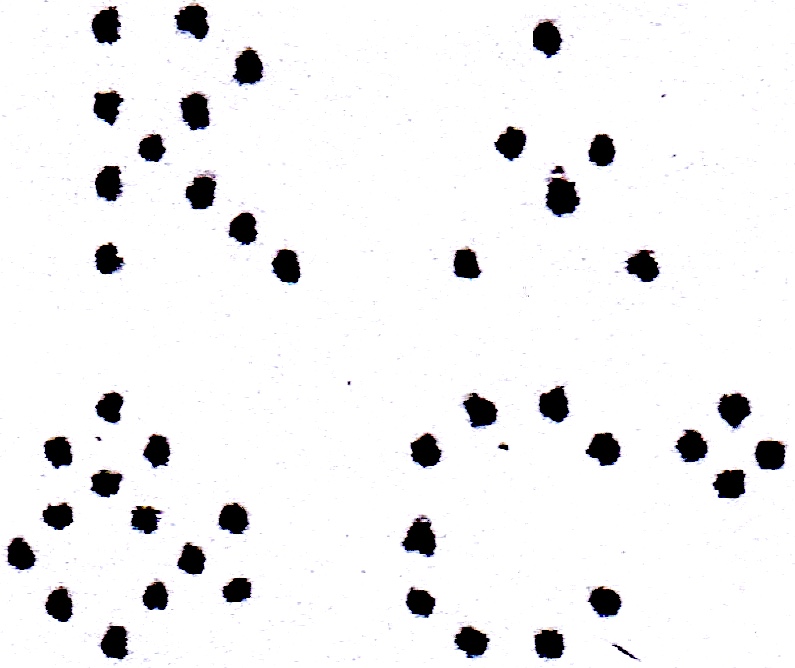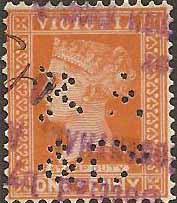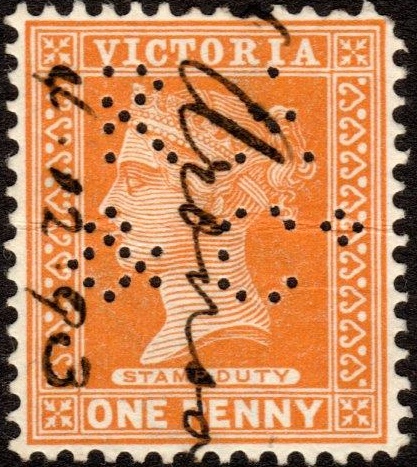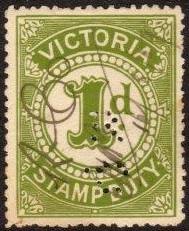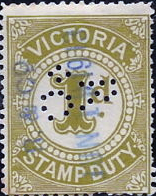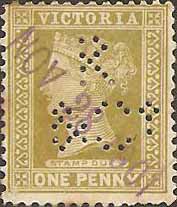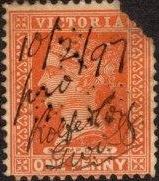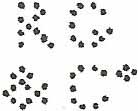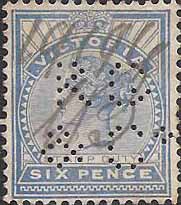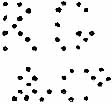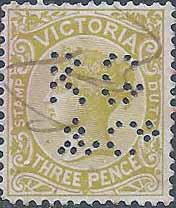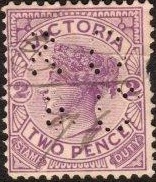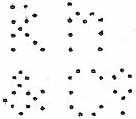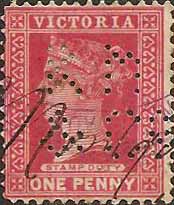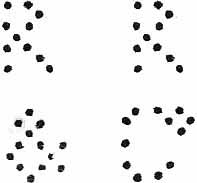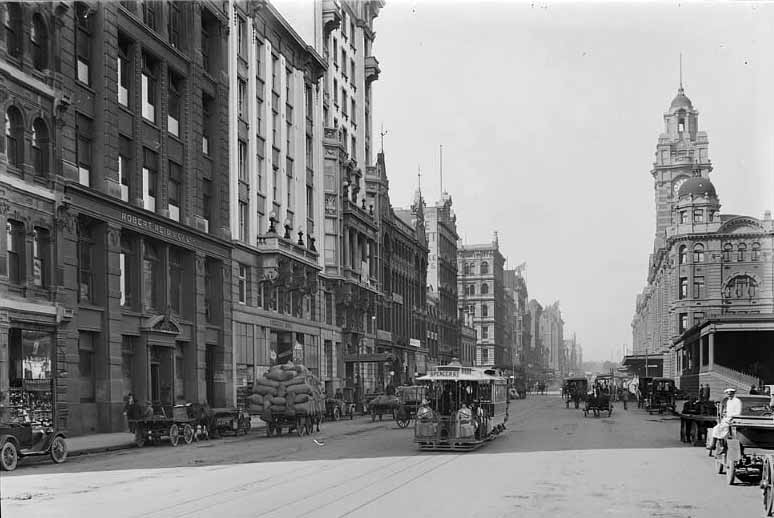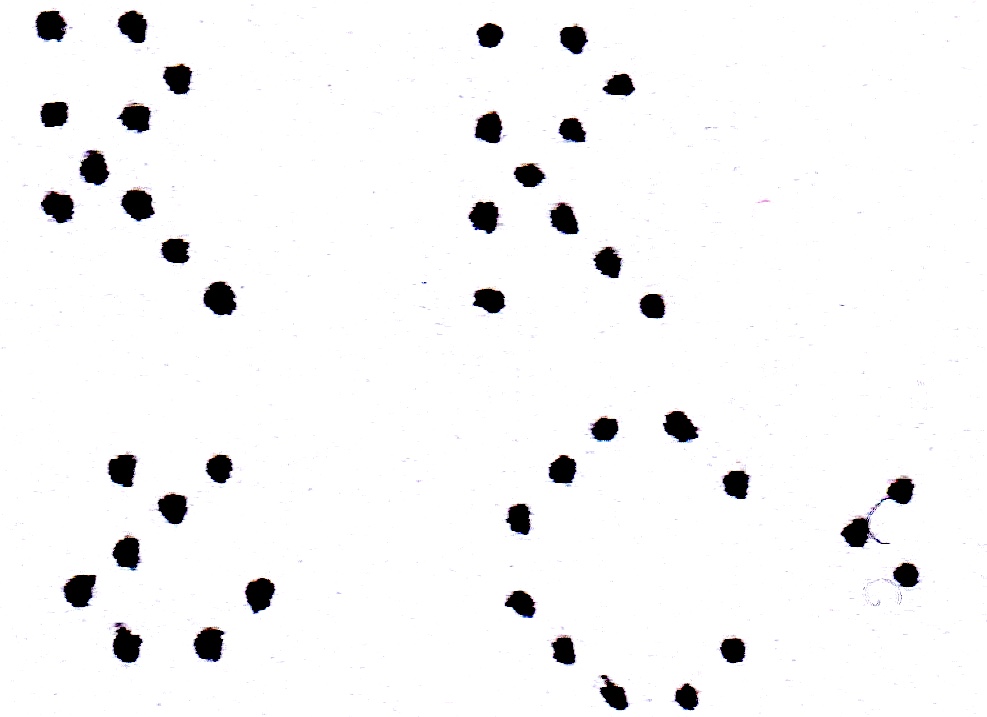|
Private Revenue Perfins of Victoria An Elsmore Coath production The authors would welcome your comments additions or input into this work A B C D E F G H I J K L M N O P Q R S T V W Y Other R -------------------------------------------------------- R.a User: Rolfe & Co Ltd Tea Merchants Address: 483-489 Bourke St, Melbourne, VIC Revenue Use: 1915 Series: 2d Rarity Scale:
1915 Series 2d R4 Background: *George
Rolfe was born in 1808, at Tenterden, Kent, where
his father was a prosperous yeoman and landed
proprietor. Educated in Tenterden, he left at the
age of 20 for London where he entered into a
business partnership which failed. He married
(1834) Marion Wordsworth Kerville, by whom he had
four children, and in 1851, in Adelaide, married
Isabella Moorehouse. In 1848, he left for South
Australia, arriving in June 1849. Rolfe commenced
business in King William Street as a land agent
with Peter Dowling Prankerd, the partnership being
dissolved on 1 January 1852. There followed a
short-lived partnership known as Rolfe, Parrott
and Bailey, valuers, auctioneers and commission
agents, selling everything from wine, spirits,
pickles, and dried fruit to cottages. In May 1854, George
Rolfe, Edward Bailey and Charles Parrott joined a
general exodus to booming Melbourne; by early 1855
however, Parrott was trading alone in Flinders
Lane. George Rolfe and Edward Bailey continued in
partnership; the business being known as Rolfe
& Bailey. The firm’s activities were now
expanded to general importers with premises at 37
Elizabeth Street. George Rolfe junior
was admitted as a co-partner in May 1860, the
business continuing to be styled Rolfe &
Bailey. At the same time, George Rolfe senior was
elected to Parliament as MLC for Northwestern
Province (1860-62). Unseated in 1863, he returned
to England where he paid off the debts sustained
15 years earlier. In 1867, he was returned briefly
to Parliament as the Member for Southwestern
Province. Unseated again, he was elected MLA for
Crowlands in 1869. In July 1866, Edward
Bailey ceased to be a partner in Rolfe &
Bailey and a new partnership was formed of George
Rolfe senior, George Rolfe junior and James Lecky,
the firm trading as Rolfe & Co. The
partnership expired in December 1870, when George
Rolfe junior and James Lecky became partners. It
was short-lived, being dissolved a year later;
Rolfe & Co. being conducted by George Rolfe
junior alone. In 1870, Rolfe senior
visited San Francisco where he married Isabella
Keeling, a distant relative of his late wife.
George Rolfe senior was a Director of the National
Bank of Australia and a major contributor to the
establishment of the Alfred Hospital. He died in
December 1871 age 71 years. George Rolfe junior
died 10 September 1919, at his home in
Warrnambool, aged 82. Under the terms of his Will,
the business Rolfe & Co. was sold to provide
for a long list of legatees. Device: The R.a is a
Single Die customised device that was used over
the period 1922 until at least 1935. Oddly some
previous studies have stated that the device was
used until 1980 but this is most likely an error
caused by confusion with the larger single R
device/pattern used by Royal Insurance in
Melbourne which is found used over the period
1970–81. Usage of R.a on
postage stamps is common but it is quite rare on
revenues. When the device was
first put into service it had medium pins, but
they did not make clear strikes in contemporary
stamps so within a few years they were replaced by
the distinctive thick pins that are most commonly
seen for this device. Only the thicker pinned
varieties of the pattern are found on revenue
stamps. Related Patterns:
VIC: R/&C.a, R/&C.b, R/&Co.a, *Jenny O’Donnell
Research -------------------------------------------------------- RA.a
User: Richard Allen & Sons Manchester Address: 164-168 Flinders Lane, Melbourne, VIC Revenue Use: 1902 Series 1d Rarity Scale:
1902 Series 1d R4 Background: *Richard Allen was
born in Sligo, Ireland in 1842 and served his
apprenticeship in the softgoods business of James
Lyons of Sligo
before migrating to Victoria as a young man. He gained colonial
experience as a commercial traveller to McArthur,
Sherrard and Copeland, and also worked for
Sargood, Son and Company. Later,
he returned to Ireland where he obtained several
agencies. He returned to Victoria in 1880 and, at
the age of 38, set up business in Flinders Lane
under the style Richard Allen & Co. Allen had
almost certainly taken John James Lee as a partner
for the partnership was advertised as dissolved at
the end of 1890, Allen carrying on the business
alone. Richard Allen &
Co were “indent and commission agents” (1881) (and
“commission merchants” by 1891) and importers. The
firm also let commercial properties and shops.
Having had several Flinders Lane addresses,
Richard Allen & Co moved, in about 1889, to
number 162a (164) Flinders Lane, which became the
firm’s permanent address. Business was good.
Through the agency of Richard Allen & Co.
Sargood, Butler & Nichol bought the “whole of
the bond and free goods” of Lister Henry’s estate
in 1888. In the hard times of the 1890s
depression, the firm sold the bulk stock of
drapery of King, King & Co. (in liquidation)
to George & George Ltd (George’s department
store in Collins Street) in 1893. In 1896, a massive
“Salvage Sale” from the firm’s main, “late warehouse and
its annexes” was held at the company’s 308
Flinders Lane premises to which the business moved
(later resuming occupancy of the original site). On 7 December 1901,
Richard Allen, “manufacturers’ agent and
importer”, admitted his son, Stanley Anketell
Allen into partnership, the firm being styled
Richard Allen Son & Co. On 1 March 1907,
Richard Allen Son & Co., warehousemen and
merchants of 164-168 Flinders Lane, Melbourne; 5
Jewin St, London and 22 Edmund Place, London, was
registered as Richard Allen Sons Pty Ltd. Allen’s
other, much younger son, Henry George Allen would
be a director of the company, with his brother,
Stanley Anketell Allen, before 1929. The impressive 5
storey brick building with bluestone basement and
hydraulic lift erected for Richard Allen, Sons
& Co. (c. 1900s) at 164 Flinders Lane was
almost certainly designed by noted architect
Anketell Henderson, Richard Allen’s
brother-in-law. Henderson designed Allen’s
residence, ‘Kooyong’, in Gladstone Parade,
Elsternwick, which in 1931 was presented by grocer
prince Frederick Cato to Methodist Ladies’ College
as its new Elsternwick campus. Henderson is also
known to have done other work for Richard Allen
(as Henderson & Smart) shop fittings
installation, October 1881; and (Henderson in solo
practice) removal of a hydraulic lift at 164
Flinders Lane, November 1912). By 1939, Richard
Allen & Sons Pty Ltd of 164-170 Flinders Lane,
Melbourne, had branches in London, Manchester,
Sydney, Adelaide, Brisbane, Perth, Hobart and
Ballarat. The ranges of goods were extensive:
“carpets, furnishings, manchester, shirts,
clothing, hosiery, mantles, dresses, silks,
linings, “Richall” ribbons, laces”. The company was
still trading in 1950. Richard Allen was a
supporter of the Young Men’s Christian Association
and was instrumental in raising funds for a hostel
for the Association. For many years, he was a
director of Eagle Star and Dominions Insurance
Company. Between 1907 and 1922 Richard Allen was a
counsellor for La Trobe Ward of Melbourne City
Council. He died at the home of his son in Upper
Macedon on 4 November 1929. Device: The RA.a pattern is
made from a temporary die in a single die format.
Such devices, which could produce these temporary
patterns, were used by some Stamp Vendors in
Melbourne mainly from the late 1800’s to the early
part of the 20th Century. This particular
pattern is fairly common on postage stamps but is
rare on revenues stamps. Now this pattern is
prone to a great degree of variability that can
all be considered to be just types of a single
pattern (see above). The settings vary with the
“A” being located in different positions in
respect to the “R”. Sometimes they are even joined
and share a pin location at the base of the “leg”
of the “R” but the scale and size of the letter
remains the same and this makes them a single
pattern. The pattern is found
used over the period 1903–1915. Related Patterns: Nil *Jenny O’Donnell
Research -------------------------------------------------------- RA/&Co.a User: Rosenthal, Aronson & Co
General Merchants,
Importers and Jewellers Address: 275 Lonsdale St, Melbourne, VIC Revenue Use: 1886-1899 Series, inscribed 'STAMP DUTY' 1d (shades) Rarity Scale:
1886-1899 Series 1d R4 Background: *David
Rosenthal was born in 1825 in Sirpce, Poland.
Described as a merchant jeweller, his name is
associated with the jewellery trade as early as
1854 (Fieldham & Rosenthal with premises in Lt
Collins Street, Melbourne). Rosenthal & Co.,
founded by David Rosenthal, was firmly established
by 1867 as wholesale jewellers and fancy goods
importers. It included brothers George Alfred
Aronson (“an urbane gentleman”) and Saul Philip
Aronson, and Charles Aronson (who was a commercial
traveller for the firm in 1867). Saul Aronson left
Melbourne in 1876 to establish premises in
Camomile Street, London, to supply the prosperous
Melbourne house with English and European
merchandise. In 1877, when George Alfred Aronson
was admitted into partnership, the firm became
known as Rosenthal, Aronson & Co. The Melbourne house
was described in 1884 as “the premier house of its
kind in Victoria”, employing eight commercial
travellers. The chief speciality of the business
was the manufacture of all kinds of jewellery. The
warehouse was a substantial bluestone building,
with large, elegant showrooms three storeys high,
at the rear of the main building. “The
firm (controlled by the Aronson brothers) is
really a band of producers and distributors”.
“Besides jewellery, chinaware, glass lamps,
earthenware, shelf goods in ironmongery,
saddlery, stationery, tobacconists’ wares, the
company is also importers of pianos, violins,
musical boxes, organs, clocks, albums,
schoolbooks and requisites, basket ware etc.” In
addition, a large branch of the business was in
propriety medicines, in particular a ‘wonder’
cure-all called “St Jacob’s Oil”. A post card of
the period reveals the firm was also agents for
life insurance and agents for brands of pianos,
cigars, perfumes, cough balsam and eye ointment. In 1887, the
partnership between David Rosenthal, Saul Philip
Aronson and George Alfred Aronson was terminated
by the retirement of Rosenthal. By this time, the
company had offices in Melbourne, Launceston,
Brisbane, London, Sydney “and elsewhere”. Rosenthal Aronson
& Co. moved to Lonsdale Street (Melbourne) in
1891, to a large three storey warehouse, (designed
by N. Barnet and built by Clements, Langford Pty
Ltd.), the business being described as “General
Merchants”. In 1901 George Alfred
Aronson retired to England where he died in his
London home some years later. In early 1910, David
Rosenthal, founder of the firm, died and a few
months later, Frederick Aronson the firm’s senior
partner retired. The company passed under the
control of various Aronson family members and
ceased to trade as Rosenthal, Aronson & Co. Device: The RA/&Co.a pattern is made from
a temporary die in a single die format. Such
devices, which could produce these temporary
patterns, were used by some Stamp Vendors in
Melbourne mainly from the late 1800’s to the early
part of the 20th Century. RA/&Co.a was a
setting of the Temporary device that was used
between 1895 and 1900 and on postage stamps it is
found in a myriad of variations with some examples
having serifs on the “R”, misplaced pins etc..
Over 80 such variations are known on postage
stamps and there are likely more, and this
indicates that the user purchased perfin stamps on
approximately a 3-weekly basis over the usage
period. RA/&Co.a is a
complex pattern and the setting up of it into the
punch head of a Temporary device would have
involved the placement of about 42–46 pins in the
grid of the punch. This is one of the main reasons
for the variation and indeed the incidences of
miss placed pins. At least 6 different
settings of RA/&Co.a are found on revenue
stamps but the patterns are still rare on revenue
stamps. Related Patterns: Nil *Jenny O’Donnell
Research -------------------------------------------------------- R/&C.a
User: Rolfe & Co Ltd Tea Merchants Address: 483-489 Bourke St, Melbourne, VIC Revenue Use: 1911 Series 1d Rarity Scale:
1911 Series 1d R3 Background: See R.a Device: The R/&C.a pattern is made from
a temporary die in a single die format. Such
devices, which could produce these temporary
patterns, were used by some Stamp Vendors in
Melbourne mainly from the late 1800’s to the early
part of the 20th Century. R/&C.a was a
setting used between 1906 and about 1910. The fact
that this Temporary pattern was used after the
company secured the customised device R/&C.b in 1907 is
actually evidence against it being the same user.
But there are examples of users continuing to
source postage stamps from Stamp Vendors who used
Temporary perfin devices and these would most
likely have been perfinned as a value add from
that Vendor. The evidence
supporting R&C.a as being Rolfe is not very
strong but the fact that R/&Co.a is now proved
to Rolfe by a manuscript (see R/&Co.a)
supports the case that the similar pattern
R&C.a is also Rolfe. R/&C.a is quite
common on postage stamps but it is very rare on
revenues. On postage stamps there are at least 45
different variations which is odd given the
comparably simple nature of the pattern. As an
indication of its rarity on revenue stamps only a
single setting of the pattern is known. Related Patterns:
VIC: R.a, R/&C.b, R/&Co.a
-------------------------------------------------------- R/&C..b
User: Rolfe & Co Ltd Tea Merchants Address: 483-489 Bourke St, Melbourne, VIC Revenue Use: 1911
Series 1d, 3d Rarity Scale:
1911
Series 1d R3, 3d R4 Background: See R.a. Device: The
R/&C.b pattern is produced on a Single Die
customised device that was used over the period
1907 until at least 1921. Late usage shows
considerable wear and tear, and the pattern is
almost unreadable which accounts for earlier
studies reporting no usage after 1919. Use on postage stamps
is uncommon but usage on revenues is very rare.
Related Patterns:
VIC: R.a, R/&C.a, R/&Co.a -------------------------------------------------------- R/&Co..a User: Rolfe & Co Ltd Tea Merchants Address: 483-489 Bourke St, Melbourne, VIC Revenue Use: 1911
Series 1d, 3d Rarity Scale:
1911
Series 1d R3, 3d R4 Background: See R.a Device: The R&Co.a pattern is made from
a temporary die in a single die format. Such
devices, which could produce these temporary
patterns, were used by some Stamp Vendors in
Melbourne mainly from the late 1800’s to the early
part of the 20th Century. Previous studies of
Australian Private Perfins have not been able to
establish a user for this pattern however during
our research for this listing we encountered a
number of revenue examples with manuscript cancels
and a single one showed confirmation of the user
as Rolfe & Co. R&Co.a was a
setting used between 1895 and about 1905. R/&Co.a is quite
common on postage stamps but it is still scarce to
rare on revenues. On postage stamps there
are at least 65 different variations (settings of
the temporary die with essentially the same
pattern) which is odd given the comparably simple
nature of the pattern. By comparison only 11 types
of the pattern are known on revenues. The company clearly
had a long-standing relationship with the Stamp
vendors who were making these temporary patterns,
and this could explain the continuation of that
relationship even after, the company secured their
own customised device, R/&C.b in 1907. Related Patterns:
VIC: R.a, R/&C.a, R/&C.b -------------------------------------------------------- RG/&Co.a User: Robertson, Grime & Co Ltd Grain Merchants Address: 352-354 Flinders St, Melbourne, VIC Revenue Use: 1886-1899 Series, inscribed 'STAMP DUTY' 6d Rarity Scale:
1886-1899 Series 6d R4 Background: *Robert
Robinson was born in Lancashire in 1832 and
migrated as a 20-year-old, occupation ‘salesman’,
aboard the John
Buchan. On his marriage
certificate (1854), Robinson’s ambition is clear,
his occupation being given as ‘merchant’. In 1855, he was
established as a grocer in Collingwood (where his
children were born) prospering sufficiently to be
a Produce Merchant in Flinders Street by 1864.
Robinson was trading in grain and produce and coal
with depots at Nos 1 & 2 Bond Street by 1875.
He was to retain an abiding interest in Victoria’s
nascent coal industry with investments in several
Moe area mines. In 1886, Robert
Robinson was joined by his son, William Jackson,
and Jeffrey Hovender Grime, the business being
styled: Robert Robinson Son & Co (Robert &
W.J & Grime J.H.) grain & produce merchant
and Commission Agent. Little is known about
Jeffrey Hovender Grime who first appears in
Melbourne in 1869 when he married Harriet Davies.
There were four sons and two daughters of the
marriage. He moved house often, from Prahran to
Carlton to Fitzroy, before residing for many years
in Richmond. At the time of his death (1905), he
was living in Auburn. By 1894, Robert
Robinson Son & Co Pty Ltd had offices at
352-354 Flinders Street, Melbourne, 161 Sussex
Street, Sydney, and branches in Romsey and
Warrnambool with an agency at Warragul. Robert Robinson died
In December 1894, thereby dissolving the
partnership. The business was carried on by his
Executrix, Ann Robinson, in conjunction with
William Jackson Robinson, and Jeffrey Hovender
Grime. By 1900, J.H. Grime had become a partner in
the company, which was now styled Robert Robinson,
Grime & Company Pty Ltd. The association was
very short lived. In 1902, Grime ceased
his connection with the business and established
his own, rival business “J.H. Grime & Co.,
late of Robinson Grime & Co., Grain, Chaff and
produce Merchants and Commission Agents” at 20
Viaduct Buildings, Flinders Street. Robert
Robinson & Co. Pty Ltd “grain, chaff and
produce merchants” continued business at 382
Flinders Street, Melbourne. Device: The RG/&Co.a pattern is made from a
temporary die in a single die format. Such
devices, which could produce these temporary
patterns, were used by some Stamp Vendors in
Melbourne mainly from the late 1800’s to the early
part of the 20th Century. RG/&Co.a is found
used on the postage and revenue stamps of Victoria
in 1894. There are reports of the pattern used
between 1894 – 1899 but we suspect that this is
based on reports of the more common and very
similar RG/&Co.c. RG/&Co.a is rare
on postage stamps and even rarer with revenue use
with only a single setting known. Related Patterns:
VIC: RG/&Co.b, RG/&Co.c * Jenny O’Donnell
Research -------------------------------------------------------- RG/&Co.b
User: Robertson, Grime & Co Ltd Grain Merchants Address: 352-354 Flinders St, Melbourne, VIC Revenue Use: 1886-1899 Series, inscribed 'STAMP DUTY' 3d Rarity Scale:
1886-1899 Series 3d R4 Background: See
RG/&Co.a Device: The RG/&Co.b pattern is made from
a temporary die in a single die format. Such
devices, which could produce these temporary
patterns, were used by some Stamp Vendors in
Melbourne mainly from the late 1800’s to the early
part of the 20th Century. RG/&Co.b is found
used on the postage and revenue stamps of Victoria
in 1895. There are reports of the pattern used
between 1896 – 1904 but we suspect that these
reports are incorrect. RG/&Co.b is rare
on postage stamps with only 3 settings known and
even rarer with revenue use with only a single
setting known. This limited number
of settings does not support the usage over an
extended period such as 1896–1904 as multiple
settings of such a complex pattern would most
likely produce variations in the positions of the
letters etc. Furthermore, usage would be found on
the issues of Victoria post the Stamp Duty period
to 1901 and again this is not the case. Related Patterns:
VIC: RG/&Co.a, RG/&Co.c
-------------------------------------------------------- RG/&Co.c
User: Robertson, Grime & Co Ltd Grain Merchants Address: 352-354 Flinders St, Melbourne, VIC Revenue Use: 1886-1899 Series, inscribed 'STAMP DUTY' 3d Rarity Scale:
1886-1899 Series 3d R4 Background: See
RG/&Co.a Device: The RG/&Co.c pattern is made from
a temporary die in a single die format. Such
devices, which could produce these temporary
patterns, were used by some Stamp Vendors in
Melbourne mainly from the late 1800’s to the early
part of the 20th Century. RG/&Co.c is found
used on the postage and revenue stamps of Victoria
in the period 1896-1897. The pattern is very
similar to RG/&Co.a except that .c is slightly
larger suggesting it was set up on a wider grid
than the earlier RG/&Co. patterns. This
similarity was most likely the reason for some of
the reported usage of RG/&Co.a. RG/&Co.c is
scarce on postage stamps with at least 14 settings
known but it is much rarer with revenue use with
only a single setting known. Related Patterns:
VIC: RG/&Co.a, RG/&Co.b -------------------------------------------------------- RM/&Co..a User: R Montgomery & Co Importers Address: 399 Little Collins St, Melbourne, VIC Revenue Use: 1886-1899 Series, inscribed 'STAMP DUTY' 1d (shades) Rarity Scale:
1886-1899 Series 1d R4 Background: *Richard
Montgomery, born in Glasgow in 1824, first appears
in the public record in Victoria in late 1858 as a
cork cutter and selling brewers’ bungs from
premises in Smith St, Fitzroy, where he retained
until 1869. In 1864, R.
Montgomery & Co., advertised as “cork
merchants”, of 40 Lt Collins St West. From 1883,
R. Montgomery & Co. advertised as “brewers’
and cordial makers’ sundries” and were acting as
brokers for aerated water and cordial
manufacturing business throughout Victoria and
interstate. Between 1878 and
1892, J.W. Moreland was a junior partner in the
firm (still located in premises at 40-42 Lt
Collins St.). When, J.W. Moreland ceased to be a
partner in 1892, Richard Montgomery took his
son-in-law, William Henderson (no apparent
relation to Arketell Henderson) and William Knight
into partnership. Richard Montgomery,
senior partner in the firm of R. Montgomery &
Co., 397-399 Lt Collins St, (late 40-42 Lt Collins
St), died at his residence ‘Rowardennan’, Lisson
Grove, Hawthorn, in September 1893, at the age of
69 years. William Henderson, living in his
father-in-law’s house, remained with the firm
until 1897 when William Knight became the sole
proprietor of R. Montgomery & Co. In 1916, the firm
became a public company under the style of R.
Montgomery & Co. Pty Ltd and moved in late
1921 or early 1922 to 19 King St, Melbourne. In May 1934, a series
of auctions were held at 192 King St, Melbourne,
on the premises of R. Montgomery & Co. Pty Ltd
at which the entire stock of corks (800 gross),
essences (1000lbs) and flavours, colours, cordial
makers’ requisites, warehouse fittings, labels,
bottles and cork cutting machines was offered for
sale. R. Montgomery & Co. Pty Ltd ceased to
exist, possibly a victim of the Great Depression. Device: The RM/&Co.a pattern is made from
a temporary die in a single die format. Such
devices, which could produce these temporary
patterns, were used by some Stamp Vendors in
Melbourne mainly from the late 1800’s to the early
part of the 20th Century. RM/&Co.a is an
extremely rare pattern and it is characterised by
the large “O” with an extra dot under it,
otherwise it is very similar to the more common
settings of perfins that were produced for the
company over the period 1900–1901, which are only
found on postage stamps. It was most likely
used in a similar period perhaps the best estimate
would be C1900 given it is found only on the Stamp
Duty issues and in particular the Red shaded issue
most common in that period. Related Patterns: Nil * Jenny O’Donnell
Research -------------------------------------------------------- RR/&Co..a User: Robert Reid & Co Ltd Warehousemen Address: 341-347 Flinders Lane, Melbourne, VIC Revenue Use: 1886-1899 Series, inscribed 'STAMP DUTY' 6d (shades) Rarity Scale:
1886-1899 Series 6d R4 Background: *Robert Reid was born
in Fifeshire in 1842 and migrated with his family
aboard the Ralph
Waller, arriving in
Melbourne in April 1855. He gained a few months
experience in retail drapery in Ballarat and
Melbourne before joining William Watson &
Sons, wholesale warehousemen of Swanston Street,
where he worked for 17 years. In January 1874,
Edward Warne took Robert Reid and John Adair into
partnership, the firm being styled Warne, Adair
and Reid wholesale drapery importers at 50
Flinders Lane East. In April 1876, the partnership
(now with a branch in London) was dissolved, the
firm now being styled Warne & Reid. New premises for a
staff of 90 were built in 1881. The following
year, a factory employing 250 people in making
men’s clothing was opened in Collingwood. A large
branch of the company was also established in
Sydney. When Edward Warne
retired in December 1887, the partnership between
“Edward Warne and Robert Reid of Melbourne, Sydney
and London”, clothing manufacturers and
warehousemen, was dissolved, and the business
became Robert Reid & Co. By 1890, the firm was
one of the largest Australian importing businesses
in Australia with branches not only in Sydney but
also Adelaide and Brisbane, London, and Glasgow. In 1898, Robert Reid
& Co., (general warehousemen, agents,
manufacturers and wharfingers, specialising in
wholesale softgoods) became a limited liability
company with its head office in a five storey
London building. Robert Reid & Co.
Ltd. and its two main subsidiaries Hustlers Pty
Ltd (incorporated in NSW) and Robert Reid &
Co. Ltd (incorporated in England), continued to
trade until October 1957 when it merged with David
Murray Holdings Ltd of Adelaide to form Reid
Murray Holdings Ltd. In 1963, Reid Murray
Holdings Ltd. was liquidated, its subsidiary
Robert Reid Ltd continuing to trade until 1966
when it was bought by Ralli Australia Pty Ltd and
merged with Paterson, Laing & Bruce Ltd to
become Paterson, Reid & Bruce Ltd. Robert Reid became
one of Australia’s foremost commercial magnates.
President of the first Congress of Chambers of
Commerce in Australasia in 1880, he represented
the Melbourne Chamber of Commerce at the Indian
and Colonial Exhibition in London in 1886 and was
a commissioner at the Paris Exhibition of 1889.
Reid was president of the Melbourne Chamber of
Commerce in 1888-90 and 1899-1902. In 1892, Reid was
elected to the Legislative Council for Melbourne
Province, and was elected three more times before
resigning in 1903. He was Minister for Defence and
Health from 1893-94. In 1901, he stood
unsuccessfully for the Senate and was restored to
the Victorian ministry in 1902 as Minister for of
Public Instruction and Health. In January 1903,
Reid was elected to the Senate to “hold the place”
caused by the death of Frederick Sargood. Robert Reid, “a great
Australian merchant” died unexpectedly from
diabetes in London in May 1904, and was buried in
Hampstead cemetery.
Robert Reid Device: The RR&Co.a pattern is made from
a temporary die in a single die format. Such
devices, which could produce these temporary
patterns, were used by some Stamp Vendors in
Melbourne mainly from the late 1800’s to the early
part of the 20th Century. RR/&Co.a is a
fairly common pattern that is found in a myriad of
settings over the period of 1896–1902. The company
were prolific perfin users and even purchased
their own customised perforating machine in 1900
which they used regularly up until at least 1927.
Despite owning their
own device they were the most frequent user of
stamp vendors who used Temporary devices, and
through these the company were responsible for the
creation of well over 100 Temporary patterns in
the period from the late 1890’s until well into
the 1920’s. These included RR, RR/C, RR/C, and
RR/&CO etc. RR/&Co.a is known
in over 55 different settings on postage stamps
but revenue use is much rarer and indeed only 2
settings on revenues have been found. Related Patterns:
Vic: RR/&Co.b * Jenny O’Donnell
Research
RR/&Co..b User: Robert Reid & Co Ltd Warehousemen Address: 341-347 Flinders Lane, Melbourne, VIC Revenue Use: 1886-1899 Series, inscribed 'STAMP DUTY' 3d (shades) Rarity Scale:
1886-1899 Series 3d R4
Background: See
RR/&Co.a Device: The RR&Co.b pattern is made from
a temporary die in a single die format. Such
devices, which could produce these temporary
patterns, were used by some Stamp Vendors in
Melbourne mainly from the late 1800’s to the early
part of the 20th Century. RR/&Co.b is a
rare pattern that has not been listed in previous
studies of Australian Private Perfins. It has some
similarities with the more common RR/&Co.a but
the .b pattern has a distinctive larger “C” that
makes it a separate pattern. RR/&Co.b is found
used around 1899 – 1901 and 2 settings are known
on postage stamps but only a single setting is
reported with revenue use. Given the
similarities in the patterns RR/&Co.a and
RR/&Co.b and their overlapping usage periods,
it is possible that the odd shaped “C” in
RR/&Co.b could have been an error in a setting
intended to be RR/&Co.a. But the difference in
appearance is sufficient to consider it a separate
pattern. Related Patterns:
Vic: RR/&Co.a * Jenny O’Donnell
Research -------------------------------------------------------- A B C D E F G H I J K L M N O P Q R S T V W Y Other © copyright 2011 |

